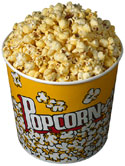
THURSDAY, Feb. 11 (HealthDay News) — The next time you sit in a movie theater with your kid and polish off a tub of popcorn, give thought to a new study that finds popular movies are filled with images of junk food.
“We’ve had a long discussion about advertising to children, what’s appropriate and not appropriate, but movies have fallen under the radar,” said study author Lisa A. Sutherland. In fact, she said, no one has studied this topic until now, although there’s been plenty of research into the roles of tobacco, alcohol and violence in movies.
Sutherland, an assistant professor of pediatrics at Dartmouth Medical School, said she was inspired to do her research after taking her son to an action-packed flick in 2003. Brand-name products were so prevalent that she thought, “there has to be something to this.”
Sutherland and her colleagues received a grant and launched their study, which analyzed the top 20 films at the box office in each year from 1996 to 2005. Researchers watched each film and noted brand-name references to food and beverage products plus retail food establishments, such as fast-food restaurants.
The findings appear in the March issue of Pediatrics.
Of the 200 movies, 69 percent — 138 — featured at least one food, beverage or retail establishment; PG-13 and R-rated movies were more likely to include the references, as were comedies, action films and horror films.
Candy products (26 percent) and salty snacks (21 percent) were the most common foods seen in the movies, and sugary soft drinks made up three-quarters of the beverages mentioned. Fast-food restaurants, meanwhile, accounted for two-thirds of the retail establishment mentions.
McDonald’s topped the references to food establishments with 13.1 percent of them, while Pepsi and Coca-Cola were nearly equal (at about 35 percent each) at the top of the list of beverage companies whose products appeared in the movies. Pepsi food products also topped the list of brand-name food references.
References to the products and restaurants is “very subliminal, much more so than advertising on television,” Anderson said. They’re “wound into the culture of the movie.”
There’s another factor to consider about exposure to food products in movies, she said: Kids often don’t just watch a film once.
Consider, for example, children watching films during long car rides. “They get hung on one DVD, and they watch it 100 times,” she said.
Parents should also be aware that even if they limit their children’s TV watching, advertising messages may sneak through when kids watch movies.
What to do? “Be aware of food advertising in movies and how it might affect your own behavior,” said Catherine Christie, chairwoman of the department of nutrition & dietetics at the University of North Florida’s Brooks College of Health. “Be careful how much high-calorie, low-nutrient food you and your children have access to and consume.”
She added that movies with food products in them could also serve as an opportunity for parents to teach children how to think critically about the images they see.
In a second, related study in the same journal, University of Minnesota researchers reported that roughly one-third of overweight teens do not consider themselves to be overweight, while those teens who did see themselves as having a problem were more likely to have tried dieting or exercise to try and shed the excess pounds.
More information
The Nemours Foundation has more on nutrition for kids.

